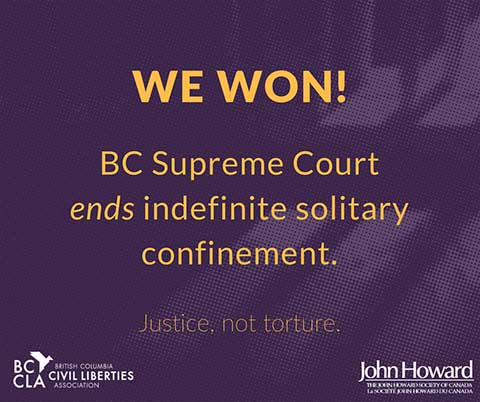A historic decision has put Canada at the forefront of an international movement against solitary confinement. The B.C. Supreme Court found that Canadian laws governing solitary (or administrative segregation) are unconstitutional, giving rise to harms that cannot be tolerated in our legal system. The laws discriminate contrary to section 15 of the Charter of Rights and Freedoms, because segregation imposes unique burdens on mentally ill and Indigenous inmates. The laws also violate section 7, because solitary risks the life and impairs the security of all who are subjected to it. The system also lacks basic safeguards, such as independent review and access to counsel at segregation hearings.

The decision breaks sharply from the deference that courts have almost invariably shown to prison administrators in the not-so-distant past. The idea that prisoners retain any legal rights at all while incarcerated is relatively new. For much of the 20th century, the "hands-off" doctrine meant that judges would not intervene in matters of prison administration. The idea was that courts were responsible for setting the length of a sentence, but prisons could carry out the sentence as they saw fit. Judges had no business second-guessing the decisions and policies of prison officials.
That tradition of judicial reticence did not appear here. Justice Peter Leask refused to accept the government's various defences at face value. The government argued that keeping inmates and staff safe is a complicated task, and that segregation is a necessary tool for maintaining institutional security. At the same time, the government denied that Canada even practices solitary confinement. The government's position, in effect, rested on the old assumption that courts should be "hands-off" and not scrutinize the work and narratives of prison officials.
Throughout his reasons, Justice Leask was skeptical of the way that the Correctional Service Canada (CSC) defended its practice of keeping inmates locked in cells for 23 hours a day. CSC argued that segregated inmates benefit from meaningful human contact on a daily basis. Cross-examination, however, revealed the limited and superficial nature of that contact. Segregated inmates eat all meals in their cells, and their exchanges with staff are brief and conducted through a food slot in their door. Once a day, they leave their cells for a shower and time alone in the yard. An Indigenous elder, trying to visit a segregated inmate to give spiritual advice, testified that he had to kneel or squat on the corridor floor to speak through the locked door.
CSC also pointed to measures in place to address the elevated risk of suicide in segregation. But measures like CSC's Suicide Risk Checklist have serious shortcomings. The Court heard from the father of Christopher Roy, a man who hanged himself in a segregation cell two months after passing the checklist.
CSC argued that administrative segregation is not punishment, unlike the system of disciplinary segregation that, ironically, grants more protections and guarantees time limits. But the Court noted how rarely disciplinary segregation is used, accounting for only 2.5 per cent of placements in 2014 and 2015. The data made clear: CSC prefers the administrative option as an easy form of sanction and control. On this and many other matters in this lengthy opinion, the judge, simply put, was not falling for it.
Notably, the Court held that the practice of isolating inmates must be subject to concrete time limits. No other court or government has been willing to go this far, but even government witnesses in this case agreed that time limits are both achievable and desirable. An actual constraint is the only way to motivate the often slow-moving and complex prison bureaucracy to get people out of solitary as quickly as possible.
A large part of why the decision looks so bold is the extraordinary amount of evidence that was placed before the court. Because of the rich factual record, much of it coming from experienced prison staff, the judge was well-positioned to assess prison realities and security issues for himself. Both the quantity and quality of such evidence were highly unusual in a prison law case. As a result, the decision is a tour de force on the history of the penitentiary and the practice and effects of solitary confinement, in Canada and internationally. It includes material from a dozen expert witnesses as well as several powerful inmate accounts. Nearly all who testified agreed that solitary can be extremely harmful and that it should be subject to strict limits. The court found that rather than making prisons safe, prolonged solitary can inflict harm on inmates and ultimately undermine security.
The testimony of law professor Michael Jackson, who has spent his distinguished career studying and trying to reform our system of solitary confinement, struck a meaningful chord with the court. Prof. Jackson admitted that developing alternatives to solitary might require building something new. But he said this would be primarily the construction of a new mindset, rather than a matter of bricks and mortar or steel and barb wire.
There are signs that this new mindset is taking shape within our current government. This decision may be a welcome excuse to finally get the required changes done.
Lisa Kerr
Globe and Mail
Jan 18, 2018